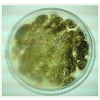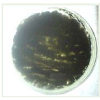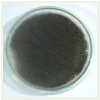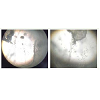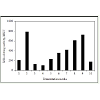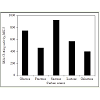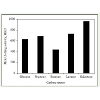Research Article
Isolation of Fungal Species and Optimization of Substrate and Carbon Source for Milk Clotting Enzyme Production
G. Baskar*, K. Prema, R. Chitra Devi
Corresponding author: Dr. G. Baskar, Department of Biotechnology, St. Joseph’s College of Engineering, Chennai - 600 119,India,; E-mail: basg2004@gmail.com
Citation: Baskar G, Prema K, Chitra Devi R. Isolation of Fungal Species and Optimization of Substrate and Carbon Source for Milk Clotting Enzyme Production. J Enzymol Metabol. 2014;1(1): 102.
Copyright © 2014 G. Baskar et al. This is an open access article distributed under the Creative Commons Attribution License, which permits unrestricted use, distribution, and reproduction in any medium, provided the original work is properly cited.
Journal of Enzymology and Metabolism | Volume: 1, Issue: 1
Submission: 13/08/2014; Accepted: 15/09/2014; Published: 17/09/2014
Abstract
Rennet is a complex of enzyme used to clot milk in the process of cheese making. Microbial milk clotting enzymes have been highly valued as calf rennet substitutes in cheese making industry. Hence the present work was focused on the isolation of potential fungalspecies from probiotic curd for milk clotting enzyme production. The isolated fungi was identified as Aspergillus species species. The effect of skimmed milk powder, peptone, soybean meal flour and their combined effect was studied and optimized for the maximum production of milk clotting enzyme using isolated Aspergillus species. The effect of various carbon sources such as glucose, fructose, sucrose, maltose and galactose on milk clotting enzyme production was also studied and optimized for maximum milk clotting enzyme production. The sucrose was identified as best carbon source for milk clotting enzyme production using skimmed milk powder combined with peptone based fermentation media. The galactose was identified as best carbon source for milk clotting enzyme production using skimmed milk powder combined with soybean meal flour based fermentation media. The maximum milk clotting activity of 923 MKUwas obtained using fermentation media containing skimmed milk powder 0.5%(w/v), peptone 1%(w/v) and sucrose 1%(w/v) as carbon source. The maximum milk clotting activity 960 MKU was obtained using fermentation media containing skimmed milk powder 0.5%(w/v), soybean meal flour 1%(w/v) and galactose 1%(w/v) as carbon source. Thus the isolated Aspergillus species was found as a potential fugal source for the production of milk clotting enzyme.
Keywords: Microbial rennet; Fungal isolation; Optimization; Milk clotting
Introduction
Rennet is an extract from the fourth stomach of young ruminants, such as cows, goats, and sheep. A majority of global reports predict a boom in the cheese market with more than 20% projected consumption between 2008 and 2015 and it is slated at 21 million tonnes by the year 2015 [1]. The average cheese consumption nearlytripled between 1970 and 2003, from 11 pounds to 31 pounds per person. Owing to the limited availability of proper stomachs for rennet production, cheese makers have looked for other ways to coagulate the milk since at least Roman times. An increase in world wide demand for cheese production per year over the past 20 years coupled with reduced supply of calf rennet, has led to a search formicrobial rennet as substitute for animal rennet [2,3].
There are many sources of enzymes, ranging from plants, fungi, and microbial sources, that will substitute for animal rennet. Cheeses produced from any of these varieties of rennet are suitable for lactovegetariansto consume. Microbial rennet have several advantagesover animal rennet. Microbial rennet is easy to produce and purify, and do not rely on the availability of animal materials [4,5]. Microbial rennet is used for one-third of all the cheese consumed worldwide at present. Moulds such as Rhizomucor miehei are able to produce proteolytic enzymes [6,7]. The milk-clotting enzyme was produced byThe Aspergillus oryzae was reported to produce milk clotting enzyme under solid substrate culture conditions [8].
The flavour and taste of cheeses produced with microbial rennet tend towards some bitterness, especially after longer maturation periods [9]. The crude enzymatic extract was produced by the thermophilic fungus Thermomucor indicae-seudaticae N31 and the hydrolytic activity profile of the enzymatic extract on whole bovinecasein was analyzed by gel electrophoresis and RP-HPLC revealed low proteolytic action towards casein fractions and a peptide profile similar to the one obtained with commercial Rhizomucor miehei protease [10]. The milk clotting enzyme from Bacillus amyloliquefaciens D4 was purified into 17.2 fold with 20% recovery by precipitation in ammonium sulfate and ion-exchange chromatography. The molecular mass of the enzyme using SDS-PAGE was found to be 58.2 kDa and proved it to be a metallo-protease by EDTA inhibition [11].
The cheese industry is seeking novel microbial sources of milk clotting enzyme for cheese production. Hence the present work was focused on the isolation of potential fungal species from probiotic curd as microbial source and to study the effect of various fermentation media with different substrate combination and carbon source on theproduction of milk clotting enzyme using the isolated fungal species.
Materials and Methods
Isolation of fungal species from probiotic curd
Aspergillus species was isolated from waste probiotic curd using Peptone-Dextrose Agar (PDA) media. The diluted sample was inoculated in PDA petri-plates and incubated at 32°C for 3 days. The isolated Aspergillus species was purified and cultivated in PDA slants at 32°C for 3 days, stored at 5°C and subcultured periodically.
Microscopic identification of isolated fungal species
The morphology of isolated pure culture was observed using macroscopic and microscopic methods. The color, formation of spores and mycelium type of pure fungal culture in petri-plates were observed. The morphological characteristics of the mycelium of the isolated fungi species was observed using light microscope (LMIBN-123001, Lawrence and Mayo, India.) [12-14].
Preparation of inoculum culture
The inoculum culture of isolated Aspergillus species was cultivated in skimmed milk powder-PDA Agar slants at 32ËšC for 3 days. The spore suspension prepared was used for the production of milk clotting enzyme.
Effect of different fermentation media
The effect of varied concentration of skimmed milk powder, peptone and soybean meal flour was studied on milk clotting enzyme production by isolated Aspergillus species. The composition (%,w/v) of various fermentation media used is given below. Media 1: Skimmed milk powder (SMP) - 0.5%, Media 2: SMP - 0.5%; Peptone - 1%, Media 3: SMP - 1%; Peptone - 1%, Media 4: SMP - 0.5%; Peptone- 2%, Media 5: SMP - 1%; Peptone - 2%, Media 6: SMP - 0.5%; Soybean meal flour (SBMF) - 1%, Media 7: SMP - 1%; SBMF - 1%, Media 8: SMP - 0.5%; SBMF - 2%, Media 9: SMP - 1%; SBMF - 2% and Media 10: SMP - 0.5%; SBMF - 3%(w/v). Other media components such as glucose 1%, KCl - 0.5%, MgSO4 - 0.5%, FeSO4 - 0.01% and pH 6 were maintained constant. The autoclaved fermentation media was inoculated with 2% inoculum and incubated in a temperature controlled shaker at 32°C and 150 rpm for 3 days.
Effect of carbon source
The effect of various carbon sources on milk clotting enzyme production by isolated Aspergillus species was studied using SMPpeptone media and SMP-SBMF media. The carbon sources such as glucose, fructose, sucrose, lactose and galactose were studied at 1% (w/v) concentration using best SMP-peptone and SMP-SMBF media.Other media components were maintained at constant as mentioned earlier. The autoclaved fermentation media was inoculated with 2% inoculum and incubated in a temperature controlled shaker at 32°C and 150 rpm for 3 days.
Estimation of milk clotting activity
The calcium chloride-skimmed milk powder solution wasprepared by dissolving 0.11 g of calcium chloride and 5 g of skimmed milk powder in 100 ml of distilled water. The calcium chlorideskimmed milk powder solution was pre-incubated for 10 min at 35°C, 5 ml of this solution was added to 0.5 ml of enzyme and the time taken for clotting of the solution was noted. The milk clotting activity (MCA) of the crude enzyme was determined using the relation in terms of milk clotting unit (MCU) was MCA=(2400*5D)/(0.5T), where, “D†is the dilution factor and “T†is the milk clotting time in seconds [15].
Results and Discussion
Isolation of fungal species from probiotic curd
The sample from waste probiotic curd was diluted and innoculated on PDA plates. The colonies grown on agar plate after 3 days of incubation at 32°C was observed as shown in Figure 1. The colony observed with uniform spores was subcultured for further isolation. The subcultured isolate grown in PDA plate was observed as shown in Figure 2. The isolated culture was subcultured in the same media for further purification and characterization. The purified fungal isolate was observed as shown in Figure 3. The purity, macroscopic appearance and colour of the isolated fungal culture shown in Figure 3 was analyzed. The isolated fungal culture was found as pure with uniform spore formation and dark grey to black in colour. The purified fungal isolate was subcultured in PDA agar slants and stored at 4°C and subcultured periodically for further use.
Pure fungal species isolated from probiotic curd using PDA media in third stage.
The microscopic characteristics of the isolated fungal species was observed under light microscope as shown in Figure 4. The mycelium was observed with thin tubular and transparent hyphae, conidiophore, conidia head with tiny black conidia. The appearance and morphological characteristics of the isolated fungal species was analyzed and found to match with Aspergillus niger. Hence the isolated fungal culture from probiotic curd was identified as Aspergillus niger [12,13].
Effect of different media composition on milk clotting enzyme production
The effect of various fermentation media containing different composition of SMP-Peptone and SMP-SBMF meal flour on milk clotting enzyme production was observed as given in Figure 5. The maximum milk clotting activity of 786.88 MCU was obtained for fermentation media 2 containing 0.5% SMP and 1% Peptone. The maximum milk clotting activity of 7277.27 MCU was obtained for fermentation media 9 containing 1% SMP and 2% SBMF. Thus the fermentation media 2 and 9 were selected for further optimization of milk clotting enzyme production using isolated Aspergillus species.
Effect of carbon source on milk clotting enzyme production
Effect of carbon source on milk clotting enzyme production using SMP-peptone media
The effect of various carbon sources such as glucose, fructose, sucrose, lactose and galactose at 1% concentration on milk clotting enzyme production using SMP-Peptone fermentation media was observed as shown in Figure 6. The maximum milk clotting enzyme activity of 923.08 MCU was obtained using 1% sucrose as carbonsource. The lowest milk clotting enzyme activity of 400 MCU was obtained using 1% galactose as carbon source. Thus the sucrose was found as best carbon source for milk clotting enzyme production using SMP-peptone media and isolated Aspergillus species.
1) Effect of carbon source on milk clotting enzyme production using SMP-SBMF media
The effect of various carbon sources such as glucose, fructose, sucrose, lactose and galactose at 1% concentration on milk clotting enzyme production using SMP-SBMF fermentation media was observed as shown in Figure 7. The maximum milk clotting enzyme activity of 960 MCU was obtained using 1% galactose as carbon source. The lowest milk clotting enzyme activity of 436.36 MCU was obtained using 1% sucrose as carbon source. Thus the galactose was found as best carbon source for milk clotting enzyme production by isolated Aspergillus species using SMP-SBMF media. The reported milk clotting activity using SBMF as natural substrate is comparable with the the milk clotting activity reported for Aspergillus oryzae MTCC 534 using wheat bran as substrate under solid state fermentation [16].
Conclusions
A fungal species was was successfully isolated from probiotic curd and found to be a potential microbial source for milk clotting enzyme production. The isolated fungal species was identified as Aspergillus species using morphological characteristics. The milk clotting enzyme activity obtained using SMP-SBMF fermentation mediawith galactose as carbon source was found higher than the activity obtained for SMP-Peptone media with sucrose as carbon source. Thus the fermentation media containing 1% SMP, 2% SBMF and 1% galactose was found as optimal media components for milk clotting enzyme production using isolated Aspergillus species.
References
- Ruchi R (2010) Cheese-Global Consumption, Worldwide Cheese Consumption Patterns.
- Bernardinelli SE, Bottaro Castilla HR, Waehner RS, Muse J, Fraile ER (1983) Production and properties of the milk-clotting enzyme. Rev Argent Microbiol 15: 95-104.
- Fox PF, Paul M, Timothy MC, Timothy PG (2004) Diversity of cheese varieties: An overview. Cheese: Major cheese groups 1-23.
- Poza M, Sieiro C, Carreira L, Barros VJ, Villa TG (2003) Production and characterization of the milk-clotting protease of Myxococcus xanthus strain 422. J Ind Microbiol Biotechnol 30: 691-698.
- Johnson E, Lucey JA (2006) Major Technological Advances and Trends in Cheese. J Dairy Sci 89: 1174-1178.
- Mariani DD, Lorda GS, Balatti AP (2003) Rennet production by Rhizomucor miehei NRRL 3169. Rev Argent Microbiol 35: 128-132.
- Lima CJB de, Cortezi M, Roberta BL, Ribeiro EJ, Contiero J et al. (2008) Production of Rennet in Submerged Fermentation with the Filamentous Fungus Mucor miehei NRRL 3420. World Applied Sciences Journal 4: 578-585.
- Shata HMA, Foda MS (2005) Production of a milk-clotting enzyme by Aspergillus oryzae under solid substrate culture conditions.
- Samson A, Shaojiang C, Jian Z (2004) Formation of bitter peptides during ripening of ovine milk cheese made with different coagulants. Dairy Science and Technology 84: 567-578.
- Carolina MD, Eleni G, Mauricio B, Roberto S (2010) Production and characterization of a milk-clotting protease in the crude enzymatic extract from the newly isolated Thermomucor indicae-seudaticae N31. Food Chemistry 120: 87-93.
- Xiaoling H, Fazheng R, Huiyuan G, Weibing Z, Xi S, et al. (2011) Purification and properties of a milk-clotting enzyme produced by Bacillus amyloliquefaciens D4. Korean Journal of Chemical Engineering 28: 203-208.
- Arima K, Iwasaki S, Tamura G (1967) Milk clotting enzyme from microorganisms. 1. Screening tests and identification of the potent fungus. Agric Boil Chem 31: 540-545.
- Larone DH (2002) Medically important fungi, a guide to identification. ASM Press. Washington D.C.
- Juan Arturo RS, Alika GE, Guadalupe LS, Juan Florencio GL, Montserrat CS (2011) Molecular identification of the fungus causing post harvest rot in jackfruit. Rev Mex Mic 34: 9-15.
- Marrouchi R, Benoit E, Le Caer JP, Belayouni N, Belghith H, Molgo J, Kharrat R (2013) Toxic C17-Sphinganine Analogue Mycotoxin, Contaminating Tunisian Mussels, Causes Flaccid Paralysis in Rodents. Mar Drugs 11: 4724-4740.
- Vishwanatha KS, Appu Rao AG, Singh SA (2010) Production and characterization of a milk-clotting enzyme from Aspergillus oryzae MTCC 5341. Appl Microbiol Biotechnol 6: 1849-1859.

